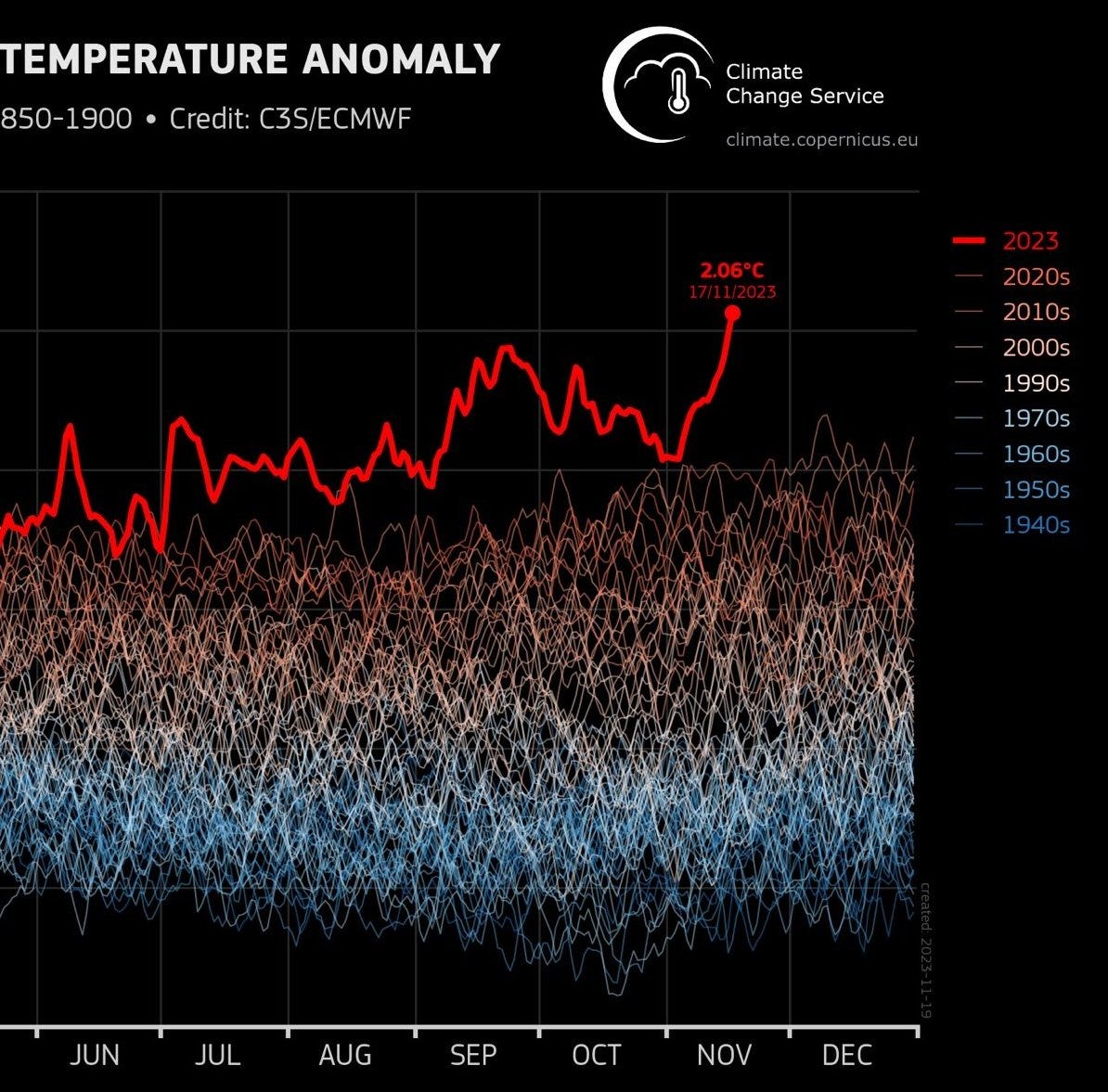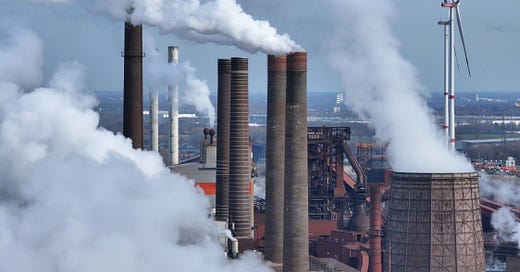
TL;DR: COP28 kicks off on November 30 and up for negotiation are issues like the role of fossil fuels in the energy transition, contributions to climate financing and the role of people and nature in achieving the Paris Agreement targets.
So, what signs of progress should we be watching out for at this year’s conference?
China and US agree to triple global growth in renewables in order to hasten the energy transition. But growing renewables and transitioning away from fossil fuels are not the same thing and attempts to characterise them as such are misleading.
Overshooting 1.5 and 2˚C in warming is part of the plan and has been for years, so why panic now? You can see the plan for yourself in this great application of the IPCC’s scenarios at World in Data.
Climate financing is key to the success of COP28, but it is paralysed by poor economic modelling of climate impacts.
Coverage of Oxfam’s annual climate inequality report highlights how inequality has become a structural impediment to climate action.
As the countdown to COP28 begins, we thought it was a good moment to preview the goals of the conference and consider how to understand progress toward them.
This is Cathrine Dyer’s weekly wrap of climate news. It is available for all paying and non-paying subscribers as part of The Kākā’s public interest journalism mandate on housing, climate and poverty in Aotearoa. Become a full subscriber to support this week and be able to comment and get access to subscriber-only content and events. The podcast above includes a chat between Bernard Hickey and Cathrine Dyer about this weekly news wrap on climate issues.
The four main goals for COP28, as set out by COP President Sultan Ahmed Jaber are:
to fast track the transition away from fossil fuels;
to transform climate finance;
to focus on the role of people and nature; and,
to ensure inclusivity for all participants.
I’ve come up with four signs for assessing how serious the COP 28 negotiators are about addressing the first three of those conference goals and put one big issue on watch.
Will the transition away from fossil fuels be fast enough?
Fast tracking the transition away from fossil fuels is the first of four conference themes at COP28.
The recent agreement between China and US was seen as key to this goal, but if you read the small print, you will have seen that neither party has actually agreed to phase out fossil fuels by a single iota. They have agreed to work on tripling global renewable energy capacity by 2030, which is good. However, it is misleading to characterise growth in renewables as a transition.
They may just be additions to global energy throughput, which needs to grow every year to support economic growth. Not one fossil fuel producing country has committed to reducing its fossil fuel production, according to the Production Gap report. While that remains the case, the predicted timing for a peak in global fossil fuel demand could be put at risk by oversupply and elongate the planet-heating post-peak tail. In truth, a full transition to renewable energy is a lot harder than it might seem, and probably impossible without demand-side strategies to constrain energy and material throughput.
A failure to fully address the hurdles to a true energy transition at this conference or any other, is an indication that countries are not yet serious about it. An actual commitment to phase-down fossil fuel production, at least in line with waning demand predictions, would be a positive sign of progress. An announcement that the transition away from fossil fuels is occurring without any agreement in place to reduce fossil fuel production is your first sign that progress is illusory.
You may be wondering why we are still talking about the 1.5˚C target at COP28 when it is likely to be already baked in. What you may not know is that overshooting 1.5˚C (and 2.0˚C as well, for that matter) is part of the grand master plan – it’s one of those plans that is so cunning, you could pin a tail on it and call it a weasel.
The Intergovernmental Panel on Climate Change (IPCC) has created a set of possible future scenarios known as Shared Socioeconomic Pathways (SSPs) that underpin the UN’s climate work. Every one of the SSPs that achieves a global surface temperature below 2˚C by the year 2100 first overshoots the target, then removes emissions from the atmosphere in the back half of the century using carbon dioxide removal technologies (CDRs), also sometimes referred to as negative emissions technologies (NETs). You can very easily see this for yourself by exploring the SSPs using this great application from ‘World in Data’.
The technology being used as a placeholder in the models right now is known as BECCS or Bioenergy with Carbon Capture and Storage. The feasibility of BECCS at scale is highly contested and it would certainly compete with food crops for land. Bioenergy or food doesn’t seem like much of a contest, but if saving the planet requires a little death by starvation and you’re good with that, I will organise the sign-up sheet for volunteers!
Some scientists have pointed to the limitations of CDR technologies in general and have called for the IPCC to have at least one pathway that maps a course in which 2˚C is achievable, without resorting to CDR. This can be done, but only if the model is not constrained by a requirement to consistently achieve year-on-year economic growth in the future.
Degrowth is currently considered to be so politically unpalatable that such a scenario is not even being explored (unlike the BECCS starvation plan). We must instead have faith in the Gods of technology and the infallibility of humankind to do what has so far proved impossible at scale. You might find it odd that so many scientists have been involved in developing a plan with so great a reliance on faith, but they are very much constrained by the politics of the UN, which dictate that we must have economic growth. The solution set is pruned to fit.
To reiterate, the reason we are still talking about the 1.5˚C target is because the plan is to whizz past it, then scramble back to it, by employing speculative emissions removal technologies. This has been the plan for many years, at least since the Paris agreement was signed.
While it’s not exactly a secret, they are just now figuring out a way to tell the world at large that there’s no reason to panic as the targets go whizzing by. The whizzing is part of the plan. But here comes the cunning part. No matter what is agreed at COP28, they will still be able to claim that staying below 2.0˚C and near to 1.5˚C is possible. We’ll just need more removals later on. And when they do make that claim at COP28, you will know that the tail has just been successfully pinned on the weasel again. That is your second sign.
Will there be enough climate finance?
Climate finance is key to the success of COP28, but probably impossible to achieve at the necessary scale as long as climate economics is so very, very broken. The best way to illustrate that brokenness is to go back to those SSPs for another look. Tick the baseline scenarios for SSP1-5. Toggle between two metrics – GDP and temperature. What you will see is that the higher the temperature goes, the more GDP there is.
At a temperature of 5˚C in 2100, global GDP in SSP5 vastly exceeds all other pathways, landing on the surreal figure of 1 quadrillion dollars! This is the burn, baby, burn all the fossil fuels path (we have, thankfully, already bent the curve below this scenario).
Most climate scientists will tell you that a modern industrial society, like the one we have today, is not consistent with 4˚C of warming (just to be clear, they are saying society would collapse before then) but the economic modelling says that the hotter the world gets from burning fossil fuels, the wealthier we will be, at every step on every one of those SSP scenarios. For context, 4˚C is about the amount of warming that it took to shift the world out of the last ice age and into the current more temperate climate in which agriculture and industrial society evolved.
Will the models adjust to make financing transition more viable?
It’s bonkers, of course. There is something very, very wrong with the economic modelling. Most people in the financial and economic worlds that work with these models know that there is something wrong here, but it’s really hard to backtrack, especially since one of the key figures behind the models, William Nordhaus, got a Nobel Prize in economics in 2018, for his contribution to climate modelling. Plus, all of our economic stability testing for climate impacts are based on these dodgy models and we’re not overly keen to acknowledge the cracks in case doing so opens them right up. Bit of a snafu that has morphed into a conundrum, old chap.
As long as the models predict that GDP will get higher, along with the temperature, it’s going to remain very difficult to stir up sufficient climate financing to prevent it or to assist global South countries to adapt to it. The logic, as modelled and presented, very clearly says that we will be better off if we don’t invest a whole lot to mitigate climate change, and there will always be more money in the future for adaptation.
Whatever the announcements at the end of COP28, it won’t be nearly enough, and you can bet your boots that it never will be, at least until they fix the economic modelling, and the true economic consequences of climate change are revealed. That is your third sign that things aren’t going in the right direction, at the right pace.
Will the transition be truly equitable?
Equity and the Sustainable Development Goals (SDGs) are key leverage points for achieving climate targets but are only rhetorically and episodically attended to by leaders. Not a single one of the 2030 SDG goals is on track.
Oxfam released their annual Climate Inequality report this week, highlighting that the richest 1% emit as much carbon pollution as two-thirds of humanity. As highlighted in this excellent Guardian piece, inequality has become a structural impediment to climate action.
Most policy efforts to address climate change within countries, attempt to make it more acceptable by spreading the costs across the total population. This approach is inequitable for the poorest, who have contributed least to the problem. As the costs grow, the likelihood that populations will continue to accept inequitable policy treatment, without protest, declines. At the same time, the rich have more power and capacity to resist having the true costs of their lifestyle choices imposed on them. This contributes to growing within-country inequality.
The idea that equity is optional still permeates the atmosphere at UN COP gatherings. But you should understand these two things. 1) Sustainability is not just a nice to have. If something is unsustainable, it must end. Even if it’s your life – if it can’t be sustained, it is over. 2) If you leave a single person or group without a sustainable livelihood, they will actively undermine everybody else’s. Nobody is going to volunteer to go away and quietly die so that the rich can keep their baubles. Because there are actual biophysical limits to growth, the rich will need to attend to the needs of the poor if there is to be any chance of avoiding a catastrophic outcome.
Failure to make a serious plan to address the SDG gap at this COP is a clear signal that the rich are reinforcing their claims on ecological space, at the expense of the rest. That is the fourth sign.
We discussed Article 6 in last week’s column. The final rulebook for Article 6.4 has been published in draft form with the goal of having countries sign off on it at the conference. The attempt to bring nature-based solutions into the global carbon trading market is another issue to watch.
Historically, the advent of markets has tended to result in land-grabs and the exclusion and/or exploitation of local and indigenous communities, even when the rules forbid it. As we noted last week, this process has already kicked off in anticipation of the market opening.
At the moment, carbon trading under Article 6.4 will require sellers to direct 5% of the proceeds to the UN authority responsible for governing the market. This does not seem sufficient to run a bureaucracy and safeguard the rights of all people subject to the market forces that will be unleashed by article 6.4, particularly given the weak enforcement power of UN agencies. Many global NGOs have plans to participate in the market, so opposition may be muted. This looks to be a ‘done deal’ and so I’m giving it observation status.
There are many futures that are still possible to contemplate for the planet, but a lot of them are truly horrible and the best ones remain unpalatable for the powerful.
UN Climate COPs are increasingly farcical, but somehow I would still rather have the possibilities they offer than the alternative, which is an absence of possibility. There are good people, doing excellent work on the edges and that is meaningful, if not sufficient. That’s undoubtedly the most any of us can hope to achieve as individuals. I hope they hang in there until the social tipping point clears a path for transformational change!
In other climate news this week
A new report from WSP and the Helen Clark Foundation emphasises that for adaptation efforts to be credible and durable, they must be built on meaningful community engagement. Their recommendations to government include honouring the spirit of partnership in Te Tiriti and adopting innovative approaches to participation and deliberative democracy.
November 17 was the first time that global surface temperatures exceeded +2˚C above the pre-industrial average according to the European Commission’s Copernicus Climate Change Service. It will likely prove to be transitory, rather than the sustained breach required to surpass Paris Agreement targets, but it is a very discomforting way station on the track and is being visited well ahead of schedule.

REDD-Monitor is reporting on an agreement by the World Bank to investigate accusations of evictions, killings and human rights abuses by its REGROW project, which aims to almost double the size of the Ruaha National Park in Tanzania. Anuradha Mittal, Executive Director of the Oakland Institute told The Guardian that,
“The REGROW project is not about protecting wildlife or conservation, instead the bank is financing an oppressive and violent economic growth model based on boosting tourism revenues.”
The establishment and expansion of conservation parks and protected areas is a contested project in which authorities make determinations about who or what activities are to be allowed within park boundaries, often without consulting the people whose lives and livelihoods are located there. A crucial question that is rarely considered is what nature is really being protected from and whether the objective is best achieved by a ‘nature without people’ or a ‘nature without markets’ model.
And lastly, this story on Australia’s ABC News is eye-opening. Global mining giant Glencore plans to remove carbon dioxide emissions from one of its coal-burning power stations, liquefy them, then inject them into an aquifer in Queensland that is connected to the Great Artesian Basin. They claim it will have no effect on the groundwater that supplies 180,000 households, as well as agricultural interests in the region. Not all experts agree, according to the ABC report,
“Hydrogeologist Ned Hamer said once the corrosive fluid was injected it would quickly cause a 10,000-fold increase in groundwater acidity, which would dissolve the aquifer rock and result in the mobilisation of heavy metals towards other existing water users.
"Those metals include arsenic and lead and other heavy metals that make the water unsuitable for any use, particularly those uses that are occurring at the moment, such as for livestock," he said.”
This has put agriculturalists and environmentalists on the same side, at least for a while, in opposing the plan.















Share this post